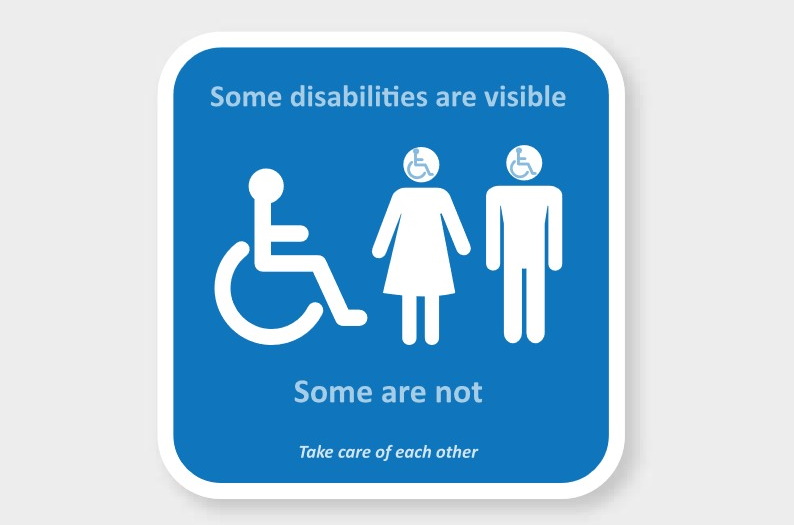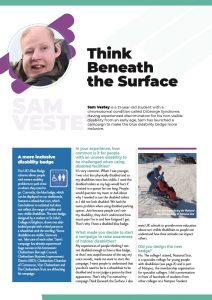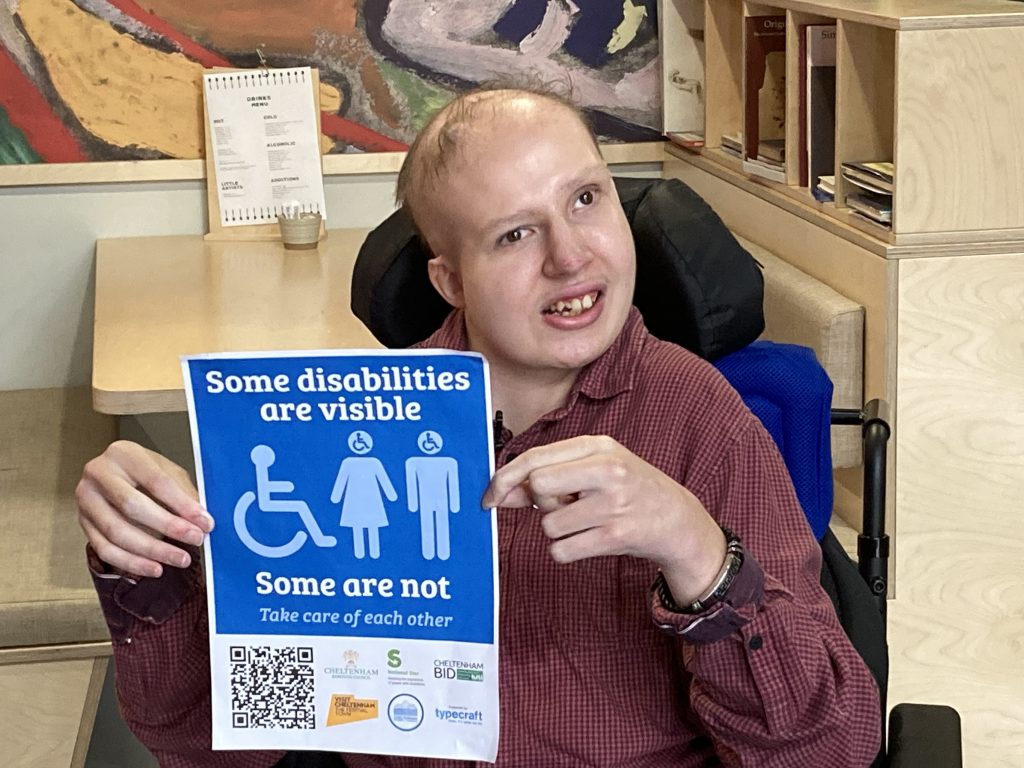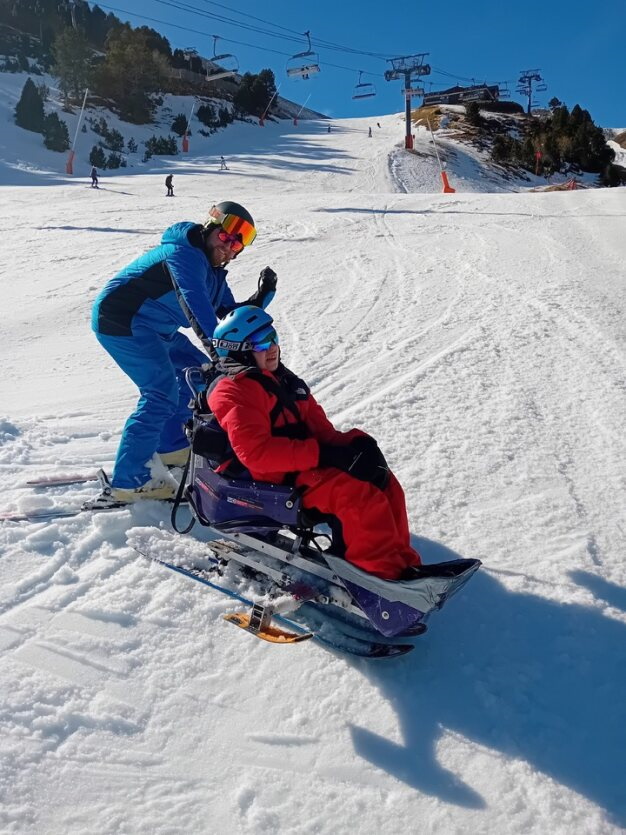Think Beneath the Surface
Sam Vestey is a 21-year-old student with a chromosomal condition called DiGeorge Syndrome. Having experienced discrimination for his non-visible disability from an early age, Sam has launched a campaign to make the blue disability badge more inclusive.
A more inclusive disability badge

The UK’s Blue Badge scheme allows people with severe mobility problems to park close to where they need to go. Currently, the blue badge, which can be displayed on car dashboards, features a wheelchair icon, which Sam believes is outdated and does not reflect the range of visible and non-visible disabilities. The new badge, designed by a student at St John’s College in Brighton, shows two able-bodied people with a third person in a wheelchair and the wording: ‘Some disabilities are visible. Some are not. Take care of each other.’ Sam’s campaign has already experienced huge success in his hometown: Cheltenham Borough Council, Cheltenham Business Improvement District (BID), Cheltenham Chamber of Commerce, Visit Cheltenham and The Cheltenham Trust are all backing his campaign.
In your experience, how common is it for people with an unseen disability to be challenged when using disabled facilities?
It’s very common. When I was younger, I was a lot less physically disabled and so my disabilities were less visible. I used the disabled toilets as my legs would hurt if I waited in a queue for too long. People would question my mum or dad about why I needed to use the disabled toilets as I did not look disabled. We had the same problem when using disabled parking spaces. Just because people can’t see my disability, they don’t understand how much pain I’m in and how fatigued I get. That’s why I have a disabled blue badge.
What made you decide to start a campaign to raise awareness of hidden disabilities?
My experiences of people thinking I was not disabled enough to have a blue badge, or that I was stupid because of the way my voice sounds, made me want to start this campaign. I want people to understand that you don’t need to be in a wheelchair to be disabled and to not judge a person by their appearance. That’s why I’ve named my campaign Think Beneath the Surface. I also want UK schools to provide more education about non-visible disabilities so people can understand how their attitude can impact others.
Did you design the new badge?
No. The college I attend, National Star, is a specialist college for young people with disabilities (see page X) and is part of Natspec, the membership organisation for specialist colleges. I did a presentation in front of hundreds of students from other colleges at a Natspec Student Voice Parliament. Natspec then ran a competition to come up with a design for a new blue badge logo. Lynette Barrett, Chief Executive of National Star and Chair of Natspec, and I chose the winner. It was designed by a student at St John’s College in Brighton and shows two able-bodied people with a third person in a wheelchair. It also has the wording, ‘Some disabilities are visible. Some are not. Take care of each other’, which is a key message. A graphic designer then donated his time to turn the design into professional logo.
Sam with his MP Laurence Robertson at the Natspec manifesto launch at the Houses of Parliament. Natspec, the membership organisation for specialist colleges, is calling for fair access to high quality further education for young people with disabilities and the opportunities to put their skills to work post college.
© National Star
What steps did you have to take to get Cheltenham Borough Council and others to back your campaign?
In the summer of 2022, to the surprise of National Star and my parents, I contacted Sky News which ran the first story. Then Marianne Sweet, Executive Communications and PR Officer for National Star, started to work with me on my campaign. The story was picked up by the Press Association and BBC Radio Gloucestershire. Alex Chalk, MP for Cheltenham and now Justice Secretary, met me and is a great supporter of the campaign. He contacted my local MP Laurence Robertson who is also supporting my campaign.
Andrew Lansley, Innovation Manager at Cheltenham Festivals, the arts charity that hosts Cheltenham Jazz Festival and three other international festivals every year, heard about my campaign. My logo was then used at the Cheltenham Festivals last year. That was the first big breakthrough. The logo was also adopted by Sidmouth Folk Festival.
Then, Lindsey Holland and Michael Ellyatt from the Chamber of Commerce got in touch with me about how they could promote the campaign. Lindsey has a hidden disability, so she understands what I am trying to achieve.
In September 2023, Cheltenham Borough Council, Cheltenham BID, Cheltenham Chamber of Commerce and Visit Cheltenham launched their campaign. One thousand window stickers were printed and distributed to local businesses to display in their windows. Regional BBC TV covered the launch and there are plans to expand the campaign to other towns. Watch this space!
Did you expect to receive so much media attention?
When I first emailed Sky News about my campaign, I didn’t expect to receive any media attention. However, looking back, I emailed them at the right time in the summer when there wasn’t a great deal of major news taking place, so I got lucky. With everything going on in the world now, you have to find the right time to get media attention. I’ve learned with Marianne that if you want to continue to get media coverage you need to move your campaign on. It’s unlikely that the media will cover the same story twice.
Where do you find the confidence to deal with the media coverage?
My disability affects my voice and how I speak so I get quite nervous when speaking to an audience. Before coming to National Star, I would get very anxious. My time at National Star and my campaign have helped me gain confidence in speaking to people. It has also led me to going out more when I’m back in my hometown. I’m particularly confident when talking about my campaign because I am passionate about it. I could just speak about it from the top of my head without any reminders or cue cards. I find it difficult to use cue cards as I often forget what I’m meant to say or don’t remember what was on them.
Are you hoping that this badge becomes officially recognised and used nationwide?
My aim is to slowly roll it out across the country with the help of the Government. My end goal is to head off to the United Nations and get this new logo recognised as the international disability badge. The current disability logo, or as it is formally known ‘international symbol of access’, was designed in 1968. While, in my opinion, it’s excellent, it’s outdated and no longer reflects the legislation, introduced in 2019, that allows people with non-visible disabilities to get a blue badge. For me it creates a negative stereotype that only people in wheelchairs are disabled and that is profoundly not true.
In September 2023, Cheltenham Borough Council, Cheltenham BID, Cheltenham Chamber of Commerce and Visit Cheltenham launched their campaign. One thousand window stickers were printed and distributed to local businesses to display in their windows. Regional BBC TV covered the launch and there are plans to expand the campaign to other towns. Watch this space!
Meet Sam

What are you studying?
At National Star College, I’m studying work outcomes. Before this, I was in a mainstream school where I gained my GCSEs, one A-level and a BTECH, a vocational qualification and A-level equivalent, but this was with 48% attendance. I missed a lot of my final year at school due to illness.
What do you hope to do after your studies?
I’m hoping to do a university degree in film studies or ICT at the University of Gloucestershire. My dream job is to be a film director.
What have you found most rewarding about this campaign?
The most rewarding thing I’ve found with this campaign is the overwhelming support I’ve had and the constructive criticism that people have given towards my campaign so I can take it on board and make it better. I’ve also been very surprised about how much support my campaign has got and hearing other people’s experiences has made me more determined to get the campaign rolling nationally and internationally.
What have you found most challenging?
The most challenging part of this campaign was gaining the confidence to speak on camera. Because my disability affects my speech, I worry about people not understanding what I’m saying or making fun of my voice or my disability. Luckily, I now have very thick skin so that sort of stuff doesn’t bother me too much. It mainly depends on how I’m feeling.
I’ve also had to get better at time management and listening to people. The confidence I’ve gained helped me on the National Star College ski experience to Andorra. It was a huge step for me to travel aboard with my peers and not with family. It was an opportunity to put my confidence and communication skills to the test and take myself out of my comfort zone.
What advice do you have for young people who are passionate about a cause but aren’t sure where to start?
I would start by talking to your parents or a teacher about it so that you can make it a project. And do your research. Find out what is out there and think about what you want to do. Your first objective may not be your end goal. I started my campaign wanting to immediately change the blue badge symbol, but it is an international symbol, so it’s going to take time to build up that support and grow the movement. I might be aiming for small goals, but I’m thinking big!




